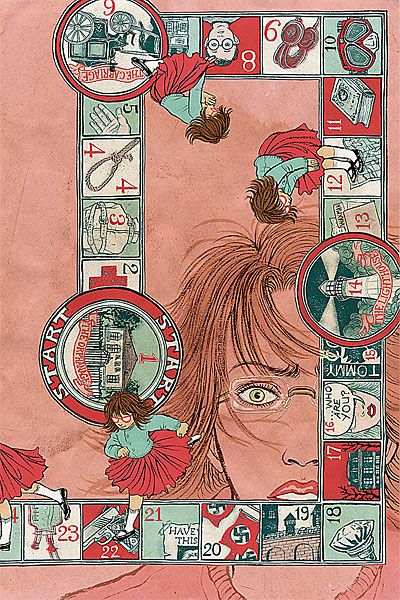"The Unwritten" #17 is one of the more ambitious comics published by DC this year, as the Vertigo series tries something very interesting: a choose-your-own comic. Basing itself upon the popular Choose Your Own Adventure books (called 'Pick-a-Story' here), this issue is told through non-linear storytelling where, at certain spots, the reader can choose between two options and continue from there. To fit all of this possible content into the 32-page comic, the book should read rotated 90 degrees and each page is divided into two, doubling the amount of pages possible. With the first two comic pages taken by introducing the concept, that leaves 60 possible pages of story. While a clever idea that relates well to the concept of "The Unwritten," ambition definitely outstrips execution here as the experiment becomes somewhat tedious because of the limitations of the issue needing to fit into the larger, serialized story of the title.
Ostensibly focusing on the past of Lizzie Hexam/Jane Waxman, "The Many Lives of Lizzie Hexam" is at its best for the first third of the various stories. Though there are numerous options, there are really only two stories presented here: one that ends 'early' and doesn't fit the series, and one that advances that story. Within each, there are numerous variations, like the motivation of a character, but, in both, those variations become somewhat meaningless. In the longer story that plays out fitting the context of "The Unwritten," two-thirds of the story has no choices as to where to go next. This is the biggest flaw of this issue as, one you hit the point where Tom Taylor and Savoy enter the story, it becomes a regular issue of "The Unwritten" except with more jumping around. The gimmick becomes unnecessary and tedious.
The choice to advance is the ongoing story is an odd one since the idea of presenting numerous variations on the 'origin' of Lizzie is a strong one. With the majority of the comic taken up presenting a strictly linear and focused story, the entire concept of the issue falls apart. It reads as if Carey got tired of the concept and decided to just write another issue of "The Unwritten." And it's a perfectly good issue of the title: Tom Taylor comes to terms with some of his problems and finds a way to connect with Lizzie. But when it's meant to be something more than a regular issue, getting the 'same old, same old' after a dozen half-pages of ambitious, experimental storytelling is a let down.
Even the initial portions with the option to choose don't provide much variety. It's often very small, subtle changes that all lead to tell one of two stories. Now, these subtle variations serve a purpose, partly because they're all possible and because they all don't actually matter. It's an interesting commentary on how all of the details provide are 'real' and how none are. It's like Lizzie is a character that's been retconned/rebooted a few times with the details changed. Everything informs the character in the reader's mind, but what actually counts?
That's the idea that I wish the issue played upon more by devoting the entire issue to Lizzie's 'origin' and providing numerous different versions, leaving the plot to continue next issue, never providing a final say on which version is the 'real' one. The expectations for the issue suggested that, rather than the continuation of Tom Taylor's adventures that takes up most of the issue, and would have been much more in line with the fantastic one-off issues of the title's past.
On the art side, Ryan Kelly steps into provide finishes over Peter Gross' layouts and delivers work that's very much in line with Gross' look. The two artists make the most of the smaller 'pages' and pack them with panels, preventing the feeling that there was any lack of content. In a couple of cases, they even get to use two full pages to connect four of the half-pages to create a larger layout with those four half-pages flowing into one another. That's an innovative and fun way to take advantage of the different storytelling method.
"The Unwritten" #17 is an ambitious comic, but it never achieves that ambition by abandoning the concept behind the issue partway through, leaving most of the story to be read like a linear, regular story, only with a lot of flipping back and forth throughout the comic. Still, the issue is a fun one that sheds light on Lizzie and furthers her story. Numerous variations on her past are provided, giving a broad view of the character and leaving it all in the readers' hands as to what 'counts' and what doesn't. Ultimately, it's a comic that's more interesting in theory than execution.

